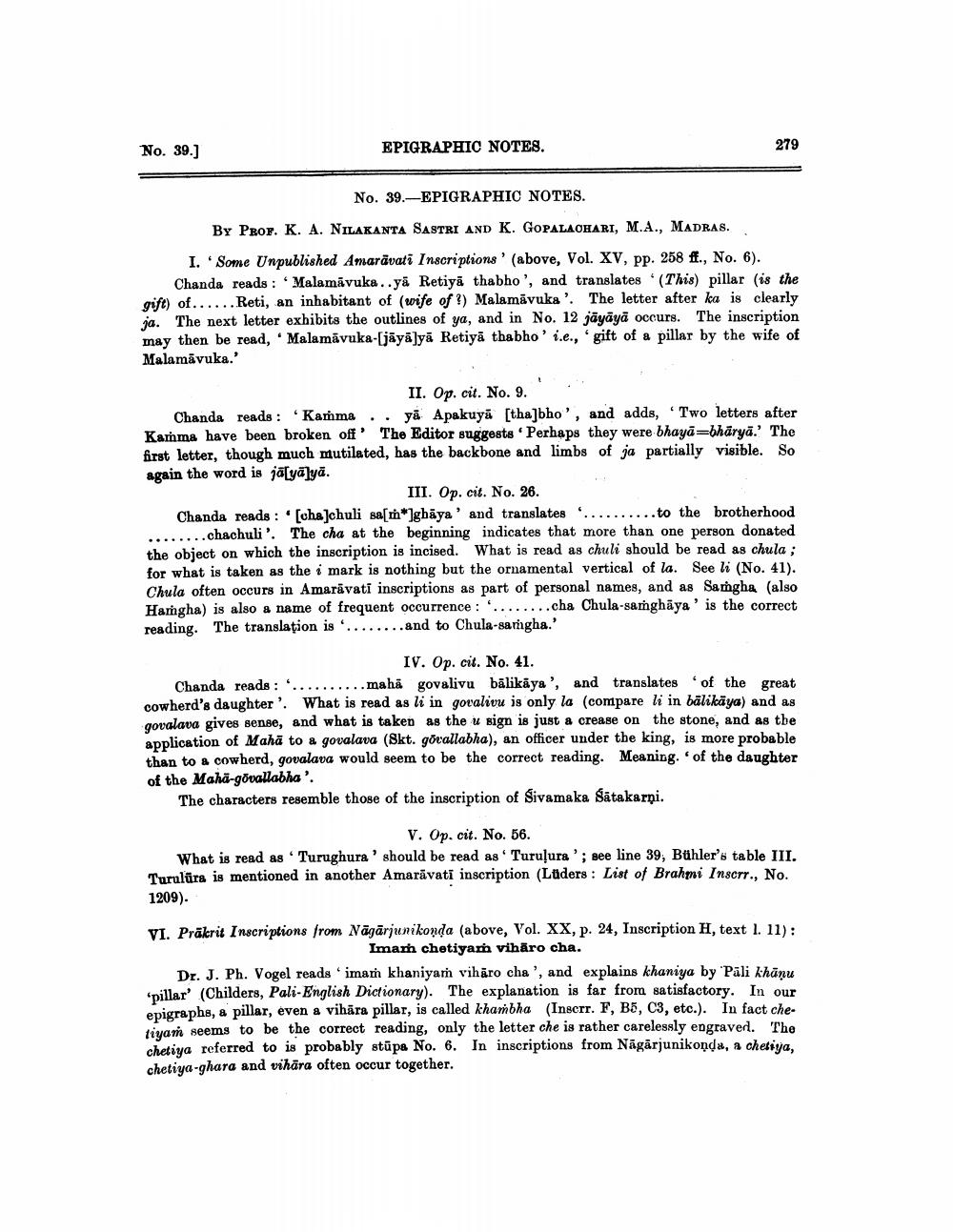________________
No. 39.]
EPIGRAPHIC NOTES.
279
No. 39.-EPIGRAPHIC NOTES. BY PROF. K. A. NILAKANTA SASTRI AND K. GOPALACHARI, M.A., MADRAS. I. Some Unpublished Amaravati Inscriptions' (above, Vol. XV, pp. 258 f., No. 6). Chanda reads : 'Malamāvuka..yä Retiya thabho', and translates (This) pillar (is the gift) of......Reti, an inhabitant of (wife of ?) Malamāvuka'. The letter after ka is clearly ja. The next letter exhibits the outlines of ya, and in No. 12 jāyāyā occurs. The inscription may then be read, Malamivuka-(jāyā]ya Retiya thabho'i.e., gift of a pillar by the wife of Malamāvuka.'
II. Op. cit. No. 9. Chanda reads : Kamma.. ya Apakuya [tha]bho', and adds, Two letters after Kamma have been broken off' The Editor suggests Perhaps they were bhayā=bhārya. The first letter, though much mutilated, has the backbone and limbs of ja partially visible. So again the word is jā[yā]ya.
III. Op. cit. No. 26. Chanda reads : chachuli sa[m"Jgbaya' and translates ...........to the brotherhood ........chachuli'. The cha at the beginning indicates that more than one person donated the object on which the inscription is incised. What is read as chuli should be read as chula ; for what is taken as the i mark is nothing but the ornamental vertical of la. See li (No. 41). Chula often occurs in Amarāvati inscriptions as part of personal names, and as Samgha (also Hangha) is also a name of frequent occurrence : ........cha Chula-samghaya' is the correct reading. The translation is .........and to Chula-sargha.'
IV. Op. cit. No. 41. Chanda reads : ..........maha govalivu bālikaya', and translates of the great cowherd's daughter'. What is read as li in goralivu is only la (compare li in bālikāya) and as govalava gives sense, and what is taken as the u sign is just a crease on the stone, and as the application of Mahā to a govalava (Skt. görallabha), an officer under the king, is more probable than to a cowherd, govalava would seem to be the correct reading. Meaning of the daughter of the Maha-govallabha'.
The characters resemble those of the inscription of Sivamaka Satakarni.
V. Op.cit. No. 56. What is read as 'Turughura' should be read as Turuļura'; see line 39, Bühler's table III. Turulûra is mentioned in another Amarāvati inscription (Lüders: List of Brahmi Inscrr., No. 1209).
VI. Prakrit Inscriptions from Nāgārjunikonda (above, Vol. XX, p. 24, Inscription H, text I. 11):
Imam chetiyam viharo cha. Dr. J. Ph. Vogel reads imam khaniyam vihāro cha', and explains khaniya by 'Pāli khānu *pillar (Childers, Pali-English Dictionary). The explanation is far from satisfactory. In our epigraphs, & pillar, even a vihāra pillar, is called khanbha (Inscrr. F, B5, C3, etc.). In fact che. tiyan seems to be the correct reading, only the letter che is rather carelessly engraved. The chetiya referred to is probably stūpa No. 6. In inscriptions from Nāgärjunikonda, a chetiya, chetiya-ghara and vihara often occur together.




